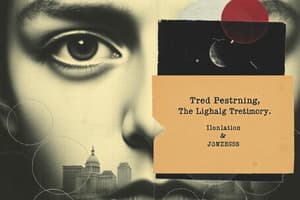Podcast
Questions and Answers
Episodic and semantic memory are considered forms of which type of memory?
Episodic and semantic memory are considered forms of which type of memory?
- Self memory
- Procedural memory
- Perceptual memory
- Declarative memory (correct)
An amnesic patient categorizing previously studied words as 'natural' or 'man-made' suggests intact:
An amnesic patient categorizing previously studied words as 'natural' or 'man-made' suggests intact:
- Repetition suppression
- Perceptual priming
- Declarative memory
- Conceptual priming (correct)
Chronic alcoholics with thiamine deficiency often develop which syndrome?
Chronic alcoholics with thiamine deficiency often develop which syndrome?
- Alzheimer's disease
- Korsakoff's syndrome (correct)
- Parkinson's disease
- Huntington's disease
Infantile amnesia may be attributed to which reason?
Infantile amnesia may be attributed to which reason?
Phil, who can remember events prior to his illness but struggles to make new memories, has which type of amnesia?
Phil, who can remember events prior to his illness but struggles to make new memories, has which type of amnesia?
What type of judgment is made in a simultaneous lineup of suspects?
What type of judgment is made in a simultaneous lineup of suspects?
Life-script theory primarily helps to explain which aspect of memory?
Life-script theory primarily helps to explain which aspect of memory?
Loftus and Palmer's (1974) study revealed that eyewitness memories can be influenced by:
Loftus and Palmer's (1974) study revealed that eyewitness memories can be influenced by:
What is a basic definition of attention?
What is a basic definition of attention?
In the retinotopic map, how is the upper visual field represented?
In the retinotopic map, how is the upper visual field represented?
What did Muller et al. (2003) find regarding the region of attention and the yellow oval target?
What did Muller et al. (2003) find regarding the region of attention and the yellow oval target?
The zoom lens model of attention is an extension of which other model?
The zoom lens model of attention is an extension of which other model?
What does the experiment by Egly, Driver, & Rala (1994) suggest about the nature of attention?
What does the experiment by Egly, Driver, & Rala (1994) suggest about the nature of attention?
What is a common goal of fMRI studies measuring perception?
What is a common goal of fMRI studies measuring perception?
According to Pinker's (1997) definition of consciousness, what can be said about awareness?
According to Pinker's (1997) definition of consciousness, what can be said about awareness?
What supports the conclusion that target detection is faster for valid trials in the Egly, Driver, & Rala study?
What supports the conclusion that target detection is faster for valid trials in the Egly, Driver, & Rala study?
In top-down (endogenous) attention, which system does it rely on?
In top-down (endogenous) attention, which system does it rely on?
In what way does the experience of insight relate to problem-solving?
In what way does the experience of insight relate to problem-solving?
What is the purpose of the dual task paradigm used by Reddy, Reddy, and Koch (2006)?
What is the purpose of the dual task paradigm used by Reddy, Reddy, and Koch (2006)?
Why is Sam's goal to become an international chess master by age 26 deemed unrealistic?
Why is Sam's goal to become an international chess master by age 26 deemed unrealistic?
Which stage is NOT part of the sequential processing in four-term analogy problems?
Which stage is NOT part of the sequential processing in four-term analogy problems?
What is a common misconception about attention mentioned in the Egly, Driver, & Rala study?
What is a common misconception about attention mentioned in the Egly, Driver, & Rala study?
What aspect of sound reasoning is evidenced in the realization of solutions to insight problems?
What aspect of sound reasoning is evidenced in the realization of solutions to insight problems?
What is a potential limitation of finding a single letter during a search task?
What is a potential limitation of finding a single letter during a search task?
What is the primary purpose of the metrical segmentation strategy?
What is the primary purpose of the metrical segmentation strategy?
Where are word boundaries likely located in terms of transitional probability?
Where are word boundaries likely located in terms of transitional probability?
How does variation in word length impact infants' ability to segment language?
How does variation in word length impact infants' ability to segment language?
What is the concept that supports the idea that hearing a word at the start and end of sentences aids in learning?
What is the concept that supports the idea that hearing a word at the start and end of sentences aids in learning?
What would be the correct number of symbols to write 'Yamaha' in the Japanese hiragana system?
What would be the correct number of symbols to write 'Yamaha' in the Japanese hiragana system?
In a writing system, when you can confidently pronounce letters but struggle to spell them, it is termed as:
In a writing system, when you can confidently pronounce letters but struggle to spell them, it is termed as:
In which type of disorder would reading unfamiliar words likely be a significant challenge?
In which type of disorder would reading unfamiliar words likely be a significant challenge?
According to the dual-route cascaded model of reading, a patient who can pronounce words with regular spellings but struggles with irregular ones would be using which route?
According to the dual-route cascaded model of reading, a patient who can pronounce words with regular spellings but struggles with irregular ones would be using which route?
What type of memory do chess masters utilize to store detailed knowledge about chess positions?
What type of memory do chess masters utilize to store detailed knowledge about chess positions?
What is the primary solution method for solving the ‘Tower of Hanoi’ problem?
What is the primary solution method for solving the ‘Tower of Hanoi’ problem?
Which statement best reflects Prospect Theory's value function?
Which statement best reflects Prospect Theory's value function?
What is the likelihood ratio based on prior odds of 0.30/0.70 and new information of 0.10/0.90?
What is the likelihood ratio based on prior odds of 0.30/0.70 and new information of 0.10/0.90?
Which of the following best defines the availability heuristic?
Which of the following best defines the availability heuristic?
Which statement is TRUE about the take-the-best heuristics?
Which statement is TRUE about the take-the-best heuristics?
According to Prospect Theory, which preference is indicated for different types of losses?
According to Prospect Theory, which preference is indicated for different types of losses?
What is the name of the structure at the back of your throat commonly referred to as the dingle-dangley thing?
What is the name of the structure at the back of your throat commonly referred to as the dingle-dangley thing?
Flashcards are hidden until you start studying
Study Notes
Memory
- Episodic and semantic memory are forms of declarative memory.
- Declarative memory can be consciously recalled.
- Semantic memory contains general facts and knowledge about the world.
- Episodic memory is autobiographical, containing specific events.
- Conceptual priming refers to faster reaction times to words that have been previously studied.
- Korsakoff's Syndrome is a neurological disorder caused by chronic thiamine deficiency.
- Patients with Korsakoff's Syndrome typically experience anterograde amnesia, meaning impaired ability to create new memories.
- Retrograde amnesia is loss of memories from before a particular event.
- Infantile amnesia refers to the inability of adults to recall memories from early childhood.
- One reason for infantile amnesia is that the brain is still developing during infancy.
Eyewitness Memory
- Simultaneous lineups present all suspects at the same time.
- The relative judgment is used when suspects are presented simultaneously.
- The reminiscence bump refers to enhanced memory for events occurring between late adolescence and early adulthood.
- Misleading information can influence eyewitness memories.
- Source monitoring determines the origin of memories.
- Source monitoring is used to assess whether information was received internally or externally.
- High threat objects can increase memory recall in an unusual context.
Attention
- Attention is a limited resource used to select information for processing.
- The retinotopic map is a representation of visual space in the brain where the dorsal portion of the occipital lobe represents the upper visual field.
- The zoom lens model of attention suggests that attention can shift to broader or narrower regions of space.
- The zoom lens model is an extension of the spotlight model of Visual Attention.
- fMRI studies of perception can be used to predict activation in the retinotopic map.
Consciousness
- Consciousness is the subjective experience of the world.
- Top-down attention is goal-directed, while bottom-up attention is driven by stimuli in the environment.
- The dual task paradigm is used to study the limits of attention.
- Attention can be object-based, meaning that we can focus our attention on a specific object rather than just a location in space.
Problem Solving
- The realization of the solution to an insight problem is preceded by an impasse.
- Chess masters have detailed knowledge about chess positions stored in long-term memory.
- The Tower of Hanoi problem is a classic example of a problem-solving task that requires planning and sequential search
Decision-Making
- Prospect theory's value function shows that losses feel larger than gains.
- Bayes Theorem is a mathematical formula used to update beliefs based on new information.
- The availability heuristic is used to estimate the probability of an event based on the ease with which examples can be recalled from memory.
- Take-the-best heuristics are a class of decision-making strategies that rely on limited information.
- Take-the-best heuristics are typically fast and accurate.
Language Processing
- The uvula is the dingle-dangley thing in the back of your throat.
- The metrical segmentation strategy uses stressed syllables as potential word onsets.
- Transitional probability (TP) refers to the likelihood of a sound following another sound.
- Word boundaries are more likely to occur when there is a drop in TP.
- The edge hypothesis suggests that words heard at the beginning and end of sentences are more likely to be learned.
Reading
- The Japanese hiragana writing system uses symbols to represent syllables.
- A writing system that is consistent in its spelling-to-sound correspondences is considered feedforward consistent.
- Phonological dyslexia is a reading disorder characterized by difficulty reading unfamiliar words and nonwords.
- There are five phonemes in the word "gnome".
- The dual-route cascaded model of reading proposes two routes: one for decoding words based on their spelling-to-sound correspondences, and one for accessing words directly from memory
Cognitive Psychology
- Cognitive psychology is the study of how people think, learn, and remember.
- Cognitive psychologists use a variety of methods to study cognitive processes.
- Cognitive psychology has applications to many different domains.
- Cognitive psychology is a rapidly growing field.
Studying That Suits You
Use AI to generate personalized quizzes and flashcards to suit your learning preferences.




